As the migration season comes to an end, the delights of winter birding in Norfolk take over. Even in the winter, the bird watching can be very exciting here. This week was certainly a good example of that.
Geese play a huge part in our winter here. The sight and sound of thousands of Pink-footed Geese flying in or out of their roost sites at dawn and dusk, or feeding in the fields during the day, is one of the real spectacles of the season in Norfolk. The flocks of Pink-footed Geese sometimes act as carriers, bringing other scarce geese with them, or attractants, pulling in other species to feed alongside. Looking through the massed ranks of Pink-footed Geese can often reveal other birds in with them.
Tundra Bean Geese are one of the more frequent species to be mixed in with the Pinkfeet, regular visitors here in small numbers, we are on the western edge of their regular wintering range. Superficially similar to Pink-footed Goose, they are most easily distinguished by having orange legs and bill band, replacing the pink. There have been good numbers of Tundra Bean Geese here in the last week or so.
A party of five Bean Geese at Titchwell earlier in the week attracted more attention. Initially reported as Tundra Beans, not surprisingly given the number around at the moment, questions started to be raised about their identity. In particular, they appeared to have a lot of orange on the bill. Tundra Bean typically has a narrow orange band around the bill, but they can be very variable. Still, it would be unusual to find five Tundra Beans together with so much orange on their bills.
Taiga Bean Goose is a different subspecies, Anser fabalis fabalis compared to rossicus for Tundra. A group of Taiga Bean Geese have traditionally wintered in Norfolk, in the Yare Valley, but they are very rare away from this area. This is one of only two areas in the UK where Taiga Beans regularly winter, the other being in Scotland. They differ from Tundra in generally having more orange on their bills, as well as a structurally different bill shape. They also tend to bigger and longer-necked. Could the Titchwell Five be Taigas?
They were certainly intriguing birds to see in the field. The bill structure immediately looked wrong for Tundra Bean, being rather long, with a thin lower mandible and lacking a prominent ‘grinning patch’, more consistent with Taigas. The amount of orange on the bills was also more in line with that subspecies. They looked long-necked when alert, but perhaps otherwise lacked some of the structural features of Taiga and did not look much larger than the accompanying Pink-footed Geese (though looking at measurements, there is a surprising amount of overlap with Taiga Bean Goose).
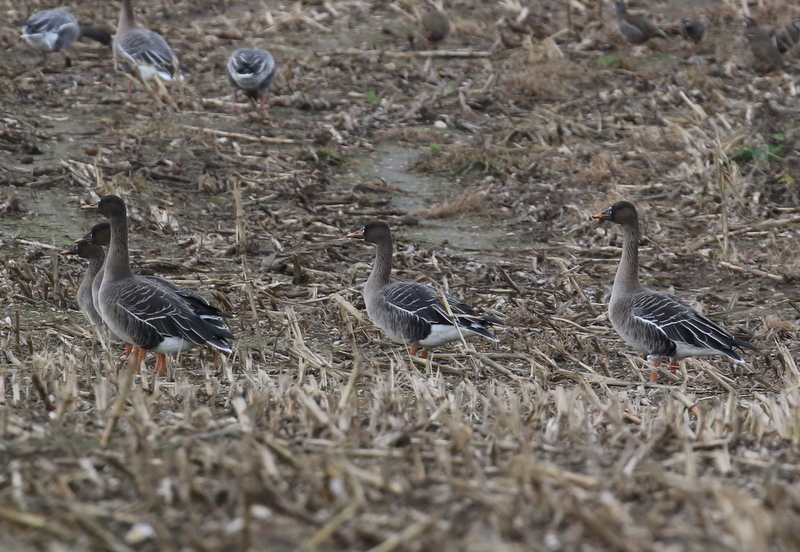
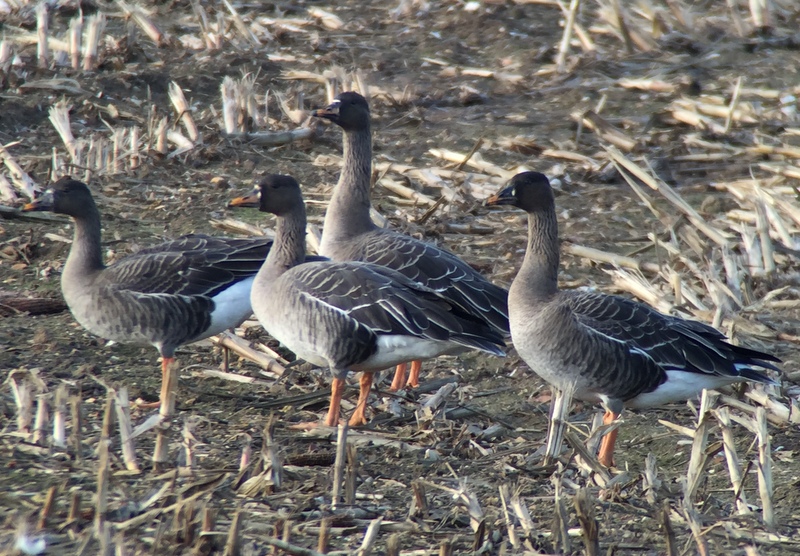 Taiga Bean Geese – these five, most likely this subpecies, were at Titchwell
Taiga Bean Geese – these five, most likely this subpecies, were at Titchwell
So, Taiga Bean Goose seemed like the best fit for these geese, even if not perfect. However, on the continent, where they are much more common, it is accepted that there is quite a lot of overlap between the two subspecies and some are considered best left unidentified to form. They were certainly Bean Geese and interesting birds to look at.
Also with the Pink-footed Geese this week has been a Todd’s Canada Goose. It took quite a bit of tracking down though, as it wandered about between the fields with the roving flocks.
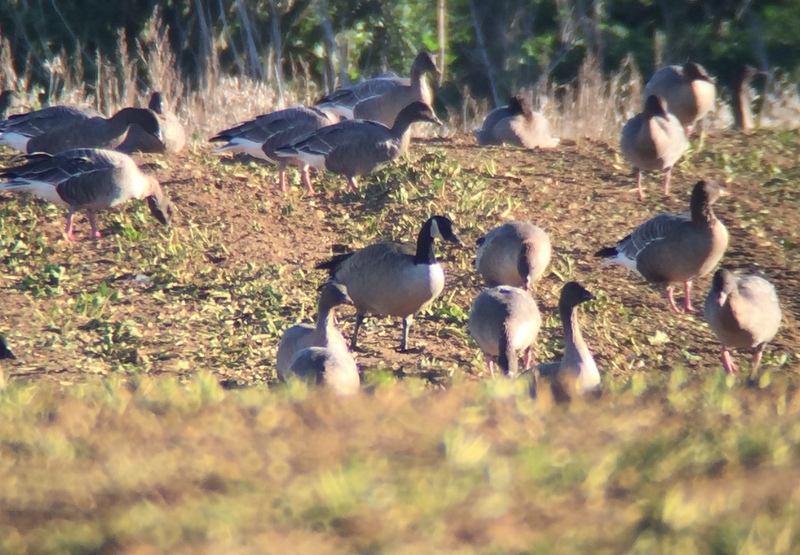 Todd’s Canada Goose – with the Pink-footed Geese in North Norfolk this week
Todd’s Canada Goose – with the Pink-footed Geese in North Norfolk this week
There is a large feral population of introduced Canada Geese in the UK, the scourge of many an urban park! However, genuine wild vagrants from North America do occur from time to time, mixed in with flocks of other wild geese, such as Pinkfeet or Barnacles. There are generally considered to be 11 different subspecies of these ‘white-cheeked geese’, which are now most commonly divided into two separate species – Canada Goose and Cackling Goose. Several of these different subspecies have been suspected in the UK in the past.
Based on size and structure of this week’s Norfolk bird, the best fit would appear to be what is known as Todd’s Canada Goose. Some video of it is included below. Hopefully it will linger now with the Pinkfeet for much of the winter.
Both Whooper and Bewick’s Swans come to East Anglia in significant numbers for the winter, and we regularly see them on our Winter Tours. There are generally large herds of both species in the Fens, particularly around Welney in west Norfolk. A smaller mixed herd typically 100-200 strong over-winters in the Broads. Small groups or family parties can often be seen arriving in from the continent at this time of year.
On Friday, a family of eight Whooper Swans appeared at Cley. Like many fresh arrivals, they seemed to be looking for a place to rest after their long journey and were first to be found loafing on the pools off the East Bank, before flying across to Pat’s Pool late morning. Interestingly, what was presumably the same family group was seen flying west along the coast later that afternoon, presumably continuing their journey to the Fens after taking a break at Cley.
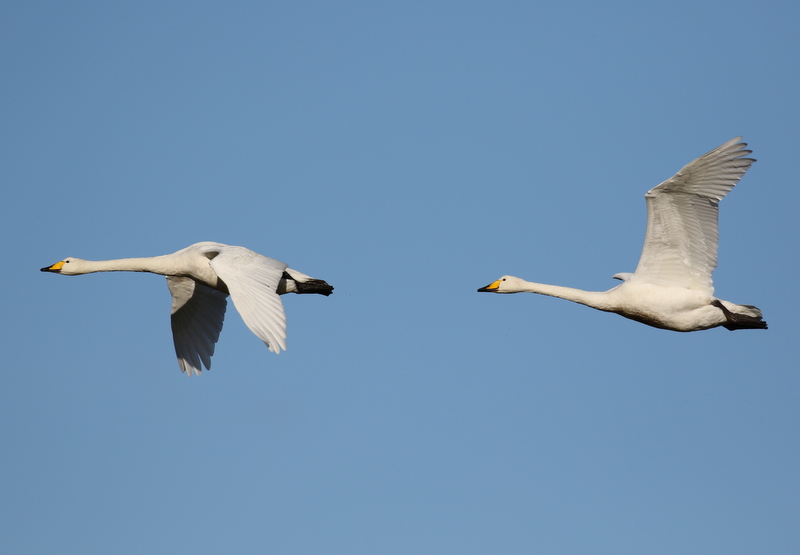 Whooper Swans – these two adults stopped off with their 6 juvs to rest at Cley
Whooper Swans – these two adults stopped off with their 6 juvs to rest at Cley
Shore Larks are also often a feature of winter here in Norfolk. They come here in varying numbers from Scandinavia each year. After a few comparatively lean years for them, this winter is looking like an exceptional one. A flock of over 70 was being recorded regularly at Holkham – an amazing sight – but the numbers here seem to have declined somewhat in recent days. It is a very popular spot for dog walkers and it is possible they were getting rather too disturbed.
This week, a smaller group of about twenty Shore Larks has been along the shingle ridge at Salthouse. They are stunning birds, with their bright yellow faces, particularly in the winter sunshine. They should hopefully stay along the coast now for the rest of the winter.

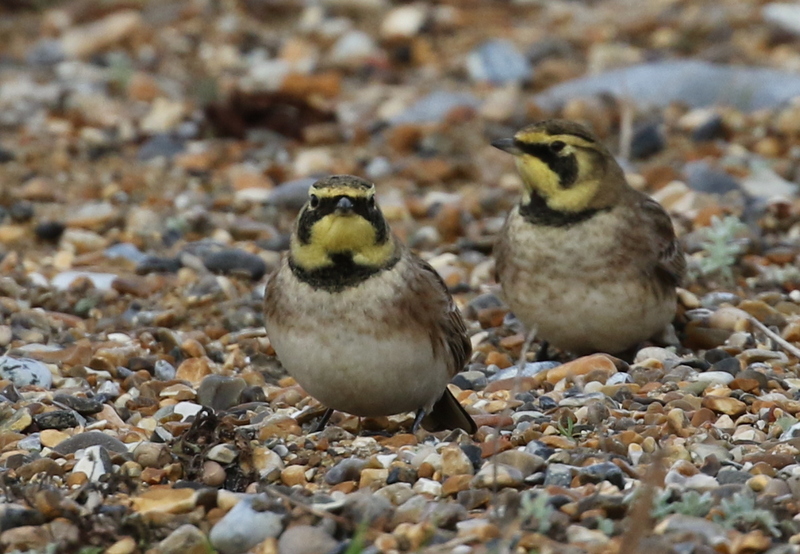 Shore Larks – it is a proving to be a good winter for this species here in Norfolk
Shore Larks – it is a proving to be a good winter for this species here in Norfolk
Snow Buntings are also a regular feature of winter along the coast here. Some good sized flocks have now started to build up at favoured sites and they are now being seen regularly. Interestingly we get a mixture of two different subspecies of Snow Bunting here each winter, mixing together freely in the flocks – nominate nivalis from Scandinavia and insulae from Iceland. The two subspecies look rather different and can be separated in the field with practice.
Snow Buntings are great birds, full of character, ekeing out a living through the winter on the beaches. They can also be very confiding at times – great for photography!
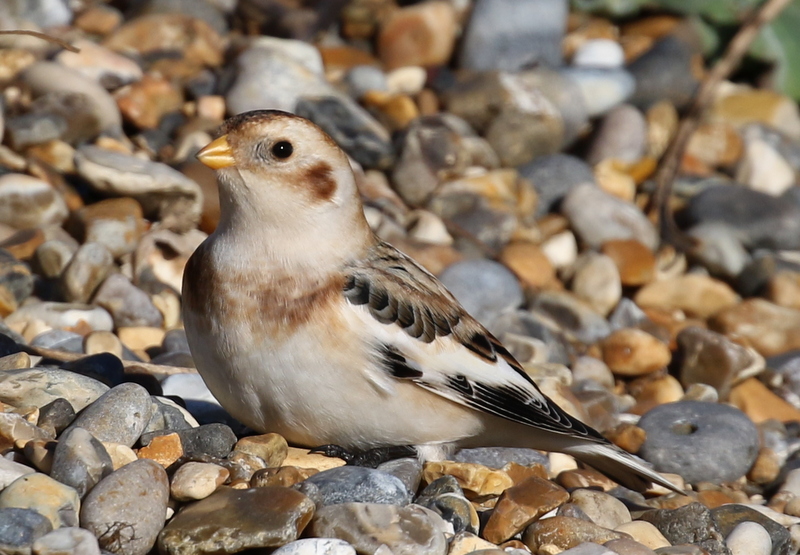 Snow Bunting – a smart male Scandinavian nivalis
Snow Bunting – a smart male Scandinavian nivalis
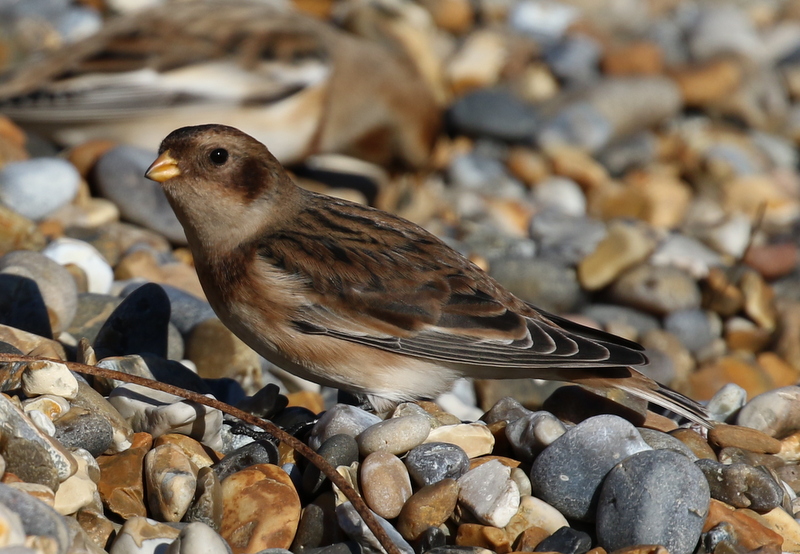 Snow Bunting – a duller female Icelandic insulae
Snow Bunting – a duller female Icelandic insulae
It is also possible to find Lapland Buntings here during the winter. There were a few this week along the coast sometimes with the Shore Larks. However, at the moment they are tending to be mobile and more often heard and seen in flight. Hopefully as winter progresses, we will have some of them settled, as we have done for the last couple of years.
Less expected things can also still turn up from time to time. Spoonbills breed in Norfolk, but most leave here in autumn and head somewhere milder for the winter. An unseasonal juvenile Spoonbill spent the day at Cley on Saturday. It is not unknown for them to overwinter here, so perhaps this individual will remain along the coast.
 Spoonbill – this juvenile spent the day at Cley on Saturday
Spoonbill – this juvenile spent the day at Cley on Saturday
There is still scope yet for 2016 to spring a bigger surprise or two. Saturday saw the discovery of a Forster’s Tern on the Stour Estuary, along the Essex / Suffolk border so a quick trip down to see it was necessary on Sunday. Forster’s Tern is a North American species, breeding across the USA into southern Canada and wintering along the Atlantic and Pacific coasts south to the Caribbean and northern Central America. It is a very occasional visitor here, with 20 previous records in Britain and more in Ireland. Records from the east coast are very unusual, with one previous record from Essex back in 1998.
Forster’s Tern in winter has a very distinctive black ‘bandit mask’, which could be clearly seen as the bird flew back and forth along the Stour Estuary in front of a grateful crowd. This bird is a 1st winter, so was born in North America during the summer and presumably got blown across the Atlantic on its way south for the winter. Several previous Forster’s Terns have stayed here through the winter before, so hopefully this one might do the same.
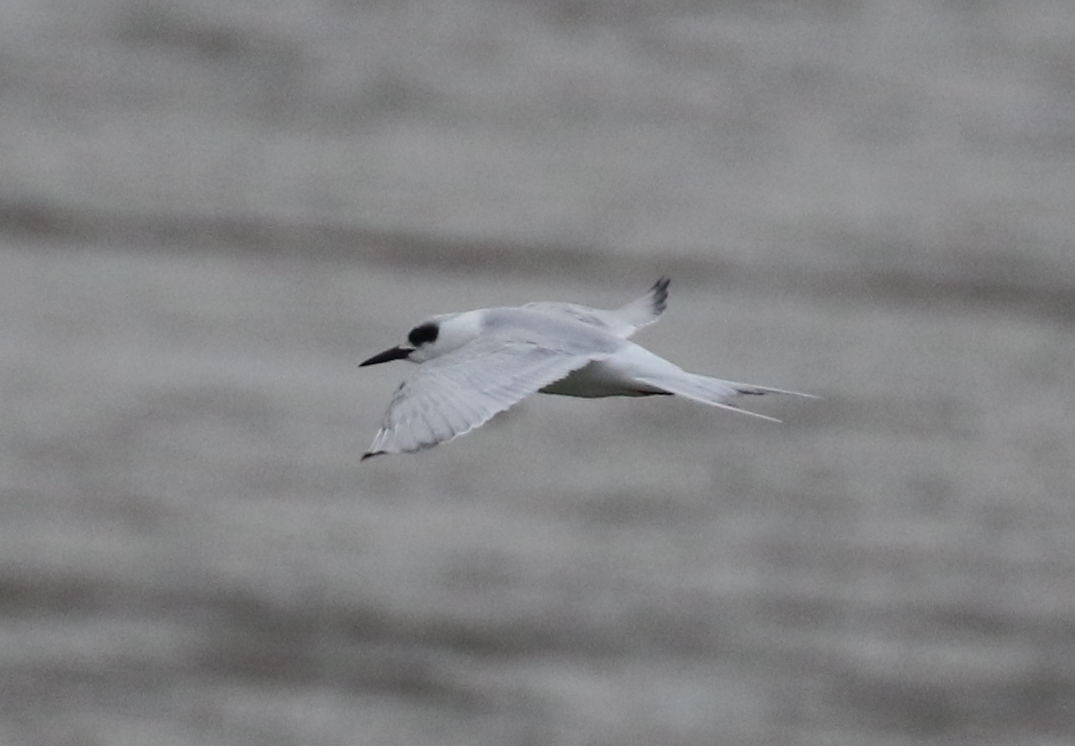 Forster’s Tern – from North America, currently on the Stour Estuary
Forster’s Tern – from North America, currently on the Stour Estuary
On the way back, we stopped off at Needham Market in Suffolk to see the Black-bellied Dipper which has taken up residence on the River Gipping. It took a little finding, but thanks to some excellent directions from one of the local young birders, we were able to locate it feeding along a mill stream.
Dippers breed fairly commonly in the UK, but are normally restricted to fast flowing rivers and streams in the north and west. They also occur as occasional winter visitors from the continent, when they can sometimes be found on lowland watercourses in East Anglia. The British birds have a distinctive chestnut belly, below the diagnostic white bib, but the belly of most of the continental visitors is all or largely black, hence this subspecies is know generally as Black-bellied Dipper.
 Black-bellied Dipper – a visitor from the continent, spending the winter in Suffolk
Black-bellied Dipper – a visitor from the continent, spending the winter in Suffolk
Black-bellied Dipper is another bird full of character. We watched it as it bobbed along beside the river, wading deep into the water and dipping its head repeatedly under to look for invertebrates in the shallows. A great bird and a great way to round off an exciting week!
If you would like to come and enjoy the delights of winter birding in Norfolk or East Anglia, please get in contact.
















